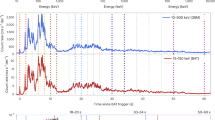Abstract
Long gamma-ray bursts (GRBs) are bright flashes of high-energy photons that can last for tens of minutes; they are generally associated with galaxies that have a high rate of star formation and probably arise from the collapsing cores of massive stars, which produce highly relativistic jets (collapsar model1). Here we describe γ- and X-ray observations of the most distant GRB ever observed (GRB 050904): its redshift2,3 (z) of 6.29 means that this explosion happened 12.8 billion years ago, corresponding to a time when the Universe was just 890 million years old, close to the reionization era4. This means that not only did stars form in this short period of time after the Big Bang, but also that enough time had elapsed for them to evolve and collapse into black holes.
Similar content being viewed by others
Main
GRB 050904 triggered the Burst Alert Telescope (BAT) on board the Swift5 satellite on 4 September 2005 at 1:51:44 GMT. The spacecraft quickly slewed to allow observations by the X-ray Telescope (XRT)6,7, which measured the burst for ten days after its onset. Figure 1 (top panel) shows the history of the burst. We shall present and discuss the GRB phenomenology from the point of view of the rest frame of its source.
WT, windowed timing mode data; PC, photon counting data. Top, evolution of the gamma-ray burst (GRB) K-corrected 0.2–10 keV luminosity (the K-correction accounts for the redshift dependence of the luminosity in a given band of wavelengths). Error bars show 90% confidence. Times are referred to the BAT trigger. Rest-frame time is obtained by applying correction factor (1+z)−1 to the observer frame time. Gaps in XRT-PC data correspond to the part of the orbit when the satellite was not observing this GRB. Bottom, change in photon index (Γ, defined by the power law F(E)=EΓ+1, where F(E) is the observed flux of energy E) of GRB 050904 during the observation. Spectra were modelled using a power law with two absorbing components (galactic and intrinsic).
The BAT light curve shows three main peaks: two of about 2 s at T+3.8 s and T+7.7 s, and a long-lasting one at about T+13.7 s, where T is the time of the burst onset. It also shows a weak peak at about T+64 s. The early XRT light curve shows a steep power-law decay with an index of −2.07±0.03; two flares are superimposed at T+64 s (coincident with the last peak of the BAT light curve) and T+170 s. Although interrupted by the constraints of low-Earth-orbit observation, the X-ray light curve reveals highly irregular intensity variations, probably due to the presence of flares for up to T+1.5 hours. At later times, flaring activity is not detected, leaving only a residual emission that is 106 times lower than the initial intensity.
The flares in the XRT light curve can be interpreted as late internal shocks related to central engine activity. In this scenario, they would have the same origin as the first γ-ray emission8,9,10, which would require the central engine to remain active for at least 5,000 seconds, consistent with the collapsar model1.
Spectral analysis was performed by selecting time intervals corresponding to characteristic phases of the light curve evolution. All spectra were well modelled by a single power law, with both galactic and intrinsic absorption components in the case of the XRT spectra. Figure 1 (bottom) shows the evolution with time of the photon index Γ. The BAT spectra have Γ=−1.2. If we exclude the spectrum of the first XRT flare at T+64 s, the XRT photon indices show a clear, decreasing trend from about −1.2 to about −1.8 in the first T+200 s. No further spectral evolution is present in later XRT data.
The overall phenomenology of GRB 050904 is not peculiar with respect to other GRBs at lower redshift. This suggests that the mechanisms of GRB explosions in the early Universe and today are similar.
Based on the likely existence of population I/II stars in galaxies that were already metal-enriched at these high redshifts11, we expect about 10% of all bursts detected by Swift to be located at z⩾5 . A higher percentage would require an additional contribution to the high-redshift GRB population by metal-free population III stars, which are viable GRB progenitors for long-duration GRBs11. A more systematic search for GRB optical counterparts will increase the sample of these high-redshift GRBs, allowing us to probe the existence of metal-free massive stars of population III.
References
MacFadyen, A. I., Woosley, S. E. & Heger, A. Astrophys. J. 550, 410–425 (2001).
Tagliaferri, G. et al. Astron. Astrophys. 443, L1–L5 (2005).
Kawai, N. et al. GCN Circ. 3937 (2005).
Becker, R. H. et al. Astron. J. 122, 2850–2857 (2001).
Gehrels, N. et al. Astrophys. J. 611, 1005–1020 (2004).
Sakamoto T. et al. GCN Circ. 3938 (2005).
Mineo, T. et al. GCN Circ. 3920 (2005).
Burrows, D. N. et al. Science 309, 1833–1835 (2005).
Zhang, B. et al. Astrophys. J. (in the press); preprint at <http://arXiv.org/astro-ph/0508321> (2005).
Nousek, J. A. et al. Astrophys. J. (in the press); preprint at <http://arXiv.org/astro-ph/0508332> (2005).
Bromm, V. & Loeb, A. Astrophys. J. (in the press); preprint at <http://arXiv.org/astro-ph/0509303> (2005).
Author information
Authors and Affiliations
Corresponding author
Ethics declarations
Competing interests
The authors declare no competing financial interests.
Rights and permissions
About this article
Cite this article
Cusumano, G., Mangano, V., Chincarini, G. et al. Huge explosion in the early Universe. Nature 440, 164 (2006). https://doi.org/10.1038/440164a
Received:
Accepted:
Published:
Issue Date:
DOI: https://doi.org/10.1038/440164a
This article is cited by
-
Ancient blast comes to light
Nature (2006)
Comments
By submitting a comment you agree to abide by our Terms and Community Guidelines. If you find something abusive or that does not comply with our terms or guidelines please flag it as inappropriate.




